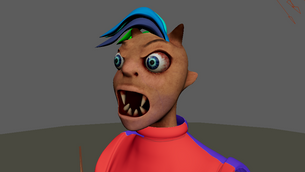Hard Surface Modelling "The Boiler Piece"
- ShrutiRoyBir

- Oct 23, 2021
- 3 min read
Updated: Oct 11, 2023
"Snap to grid" gives an opportunity to joint multiple objects together and solve many problems in hard surface modelling.

This complex-looking structure, while appearing intricate, was surprisingly straightforward to model. The initial focus was on ensuring the integrity of the overall shape, which involved identifying two key circular elements from the reference picture. The challenge lay in connecting these elements in a manner that preserved the intended shape.
The key to successfully addressing this challenge was the utilization of the "Snap to Grid" option, which proved to be a powerful tool. By applying this function strategically, the intricate connection and alignment of components became a far more manageable task. Ultimately, this approach facilitated the accurate reproduction of the desired shape, resulting in the successful completion of the modeling project.

And finally the basic shape have been achieved as shown in the below picture.

To finalize the temperature screen component and the two buttons, I executed the following steps:
Extrusion for Circular Hole: Initially, I conducted an extrusion of the middle part, creating a circular hole that would accommodate the temperature screen. This action was essential for fitting the screen seamlessly into the design.
Creating Holes for Buttons: Subsequently, I generated two holes in the design to properly secure the buttons. These holes were strategically placed to ensure a snug fit for the buttons.
Mirroring for Completion: To complete the circular shape and ensure symmetry, I executed a mirroring operation. This helped in achieving a balanced and aesthetically pleasing design for the temperature screen and buttons.
These steps were integral in finalizing the visual and functional aspects of the temperature screen and buttons, contributing to the overall success of the project a visual presentation below...


Occasionally, unexpected errors can arise during the modelling process. For instance, I encountered an issue while attempting to mirror an object; instead of mirroring as expected, the object was pasted in an unintended location. It's important to note that, while there might be more straightforward and rapid solutions available, ensuring a proper mirroring operation across the x-axis necessitates attention to detail.
To rectify this issue, it's crucial to make certain that the object or group you intend to duplicate and mirror has its pivot points precisely set to 0, 0, 0 in the XYZ coordinate space. This can be expediently achieved by entering "0" in each of the respective XYZ boxes located at the top of the Maya window and then hitting "Enter." It's worth acknowledging that sometimes, we might encounter issues due to ignoring the minor details.

And for the timer part just extruded the circle inside and secured the edges as shown bellow.


In a similar fashion, I have created two additional buttons. The process of creating holes for these buttons and ensuring that the edges are properly baked to maintain the intended shape can often pose a challenge. Converting the geometry into quads can be time-consuming, but by diligently following the provided instructions, I was able to address and rectify these issues.

Fun Fact
The concept of "Snap to Grid" presents an opportunity to seamlessly connect multiple objects, offering practical solutions in the domain of hard surface modelling.
Shortcut keys and useful tools
During this workshop, I've employed several valuable tools and keyboard shortcuts:
Edge Loop Creation at a 90-Degree Angle: To generate an edge loop at a precise 90-degree angle, you can press and hold both the SHIFT and CTRL keys.
Target Weld: This function facilitates the merging of two vertices, effectively combining them into a single point.
Slide Tool: For the purpose of evenly adjusting or repositioning edges, the Slide Tool is employed, ensuring a uniform distribution of edge positions.
Duplicate Special: This tool is used to duplicate an object while maintaining precise control over its placement by specifying particular coordinates.
These techniques and tools play a significant role in enhancing the efficiency and precision of hard surface modelling processes.









Hey, great to see you making your way through these workshops. Narrative is pretty good, but perhaps you could go a bit deeper. For example "but somehow following the instructions, I fixed it" - what was the problem, how was it resolved. Also try use the correct terminology and avoid too many spelling errors". Creating hole for buttons and baking (did you mean beveling, fencing, inserting edge loops?) the ages (edges) to maintain the shape always a challenge as it take time to figure out how to convert it to squads (quads)".